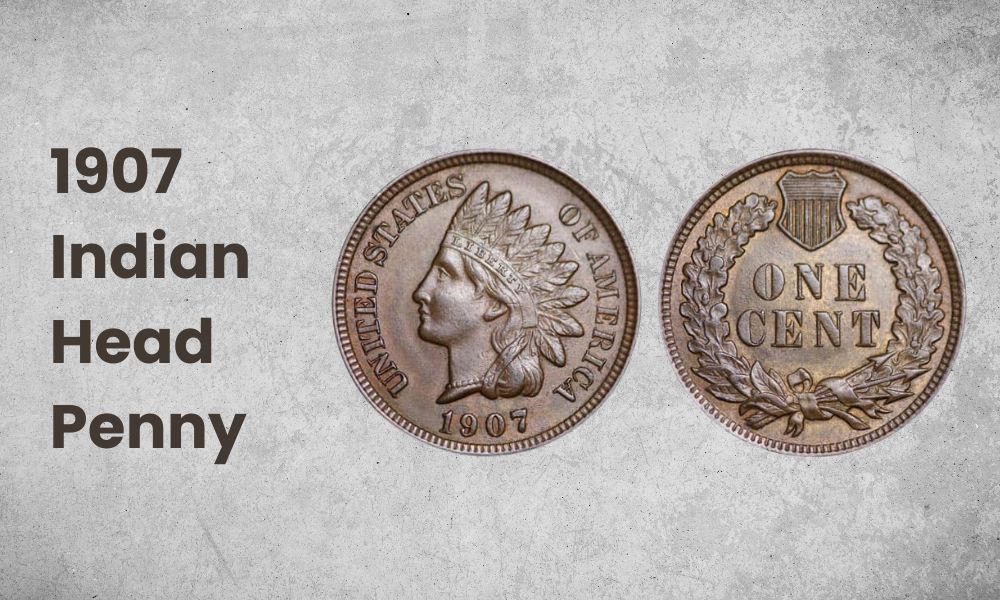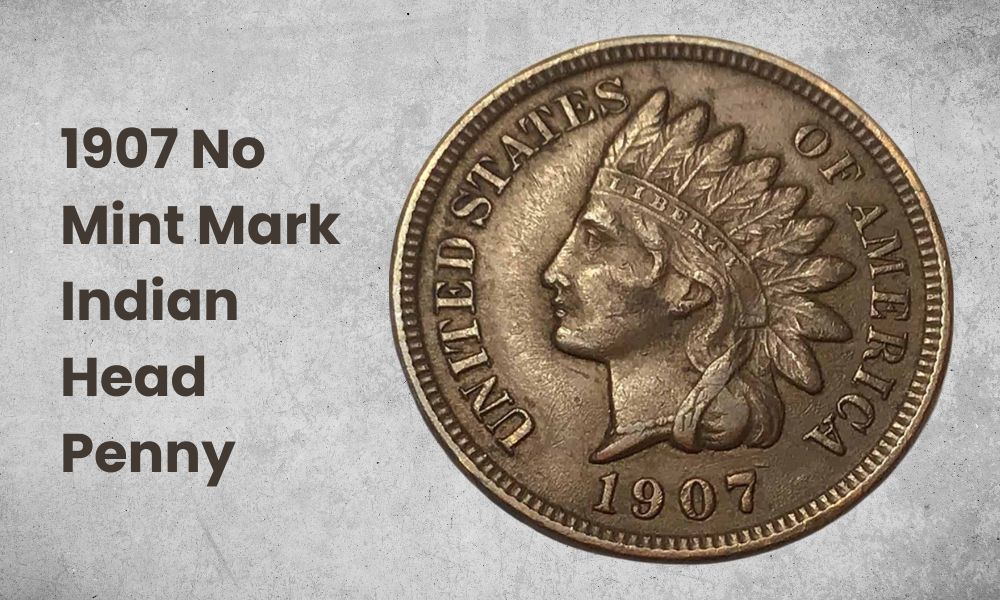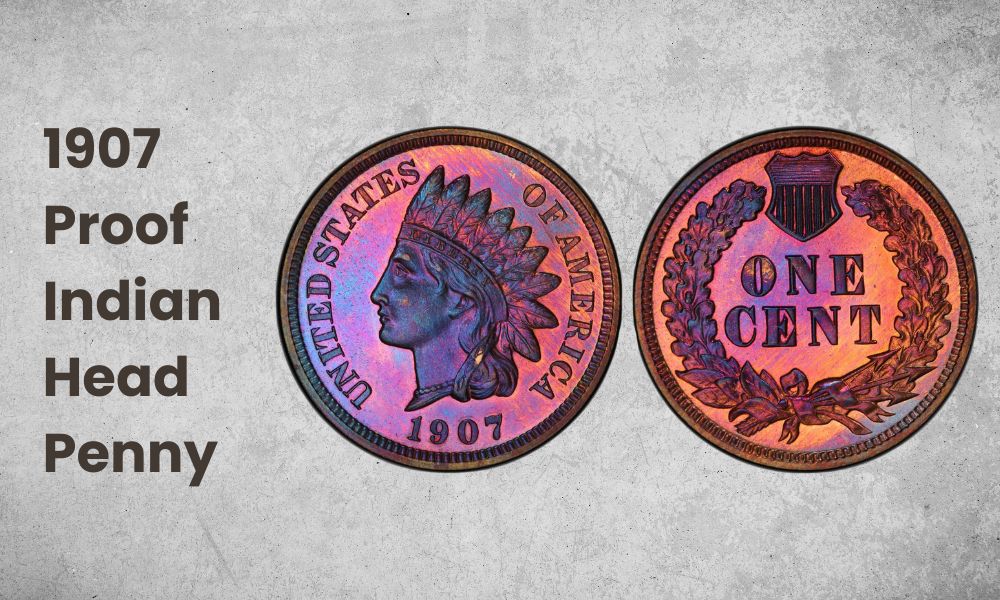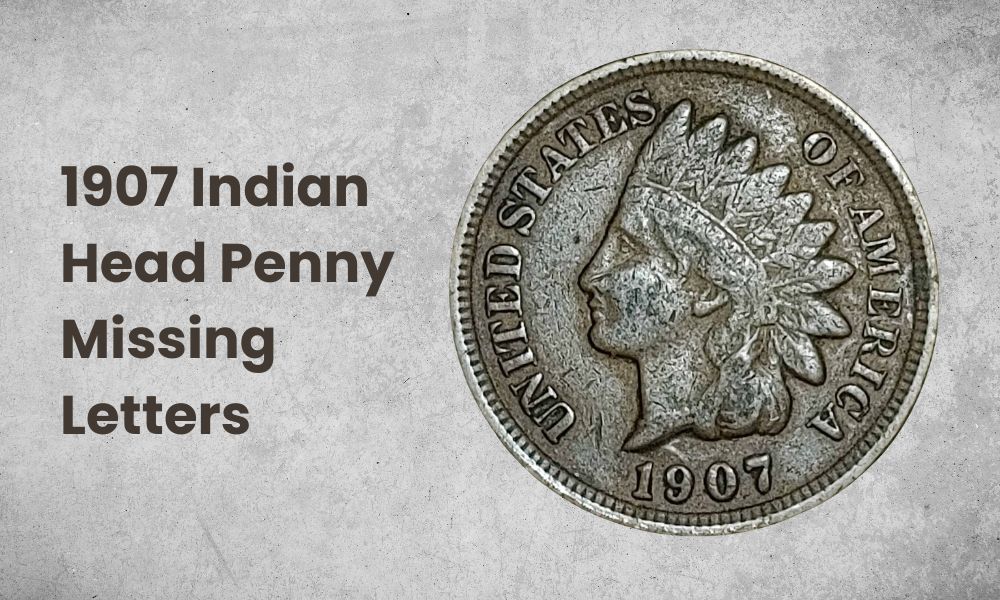If you are reading this article, you are probably wondering about the value and worth of the 1907 Indian head penny. Unlike gold and silver coins that are always worth their weight in silver or gold, the 1907 Indian head penny is not made of those precious metals.
Therefore, its value is much less than compared to those types of coins. However, this does not mean that these coins are worthless. On the contrary, some rare specimens of the 1907 Indian head penny can actually be very valuable and sought-after by numismatists.
So, let’s check out the value, variety, and history of these tangible pieces of history!
1907 Indian Head Penny Details

- Mint: Philadelphia
- Designer: James B. Longacre
- Mintage: 108,137,143
- Composition: 95% copper and 5%zinc and tin
- Mass: 3.11 grams (0.1097 ounces)
- Face value: 0.01 (one cent)
- Diameter: 19mm (0.74803 inches)
- Shape: Round
- Edge: Plain
- Mint Mark: No mint mark
As noted earlier, the 1907 Indian head penny is not made of valuable metal, meaning it does not have great value. However, some pieces can cost an astonishing amount. Keep in mind that those coins are very rare and hard to come by.
The mintage number of the 1907 Indian head penny is pretty high-108,137, 143, meaning that many of these are available, which immediately depreciates their value. However, they still have some value, as pieces of history or as a keepsake.
The only mint facility that produced these coins in 1907 was in Philadelphia; therefore, these coins do not have a specific mint mark.
The design was done by James B. Longacre, the famous American engraver and portraitist who also designed several other valuable American coins, such as Liberty Head Gold Dollar. When you see the coin, the first striking feature is the earthy-brown color.
On the obverse of the 1907 Indian head penny, you can see a Native American image with an original headdress. The image is positioned at the coin’s center and surrounded by the “UNITED STATES OF AMERICA” alongside the rim.
On the coin’s bottom rim is the year of mintage “1907”. On the reverse, the denomination “ONE CENT” is at the coin’s center, and a shield is above it. The oak wreath surrounds the denomination alongside the rim of the coin.
At the lower bottom of the coin, you can also see three arrows at the base of the wreath and a ribbon, seemingly holding the arrows.
1907 Indian Head Penny Value Chart |
|||||
| Mint Mark | Good | Fine | Extra Fine | MS 60 | MS 63 |
| 1907 No Mint Mark Indian Head Penny Value | $2-$4 | $5-$6 | $10-$13 | $40-$50 | $60-70 |
| 1907 Proof Indian Head Penny Value | / | / | $45-$65 | $160 | $160-$450 |
1907 Indian Head Penny Value and Variety Guides
As noted, these coins were only produced in Philadelphia, meaning there are no varieties, except for the proof coins, also minted in Philadelphia. Considering the high mintage and the coin’s composition, collectors do not consider it very valuable and sought-after.
However, passionate numismatists tend to acquire these because of the history of the coin and the exciting design, depicting a Native American image with a headdress and the inscription Liberty on it.
Therefore, if you are looking to sell this coin, you will not be able to sell it for a higher amount unless it has a specific error, which boosts the coin’s price. If you are familiar with the grading system, you probably know it is complicated and can be different for certain coins.
Some general factors that affect the value of any coin are the mintage number, year of minting, mint mark, rarity, demand, provenance, and condition. The worth of the 1907 Indian Head penny is affected by its condition whether it circulated, and the level of damage and tear.
As noted, you can acquire high-quality specimens with no wear interruption, which can cost $30 and more. Generally, in mint state, they can cost from $50 to $75$. However, the exact specimen in mint state with a re-punched date can cost around $200.
Those specimens that are in MS64 and have a re-punched date can cost over $400. Although most of the coins circulated and have visible damage, you can still find specimens that are uncirculated and in mint state.
However, considering the high mintage number, they are less valuable than other coins. Also, demand is vital in determining the coin’s value, especially when it is not made from precious metals such as silver and gold.
1907 No Mint Mark Indian Head Penny Value

- Category: Indian Head Penny
- Edge: Plain
- Mint Mark: /
- Mint: Philadelphia
- Year of minting: 1907
- Face Value: $0.01 (one cent)
- Price: $2 -$150
- Mintage Number: 108,137,143
- Designer: James B. Longacre
- Metal Composition:95% copper and 5% zinc and tin
- Diameter:1 mm (1.5 inches)
The year 1907 had one of the highest mintages ever. This means that the coin’s value is not exceptionally high or sought-after by the collectors. The fine or good condition specimens cost between $2 and $4, while those in better condition, such as extra fine, can cost around $11.
You can also find the uncirculated 1907 Indian head penny, and their price ranges between $20 and $25, depending on the state and condition. Those in higher grades, such as MS 60, cost around $40 to $45, while specimens with MS 63 cost between $60 and $65.
The 1907 Indian head pennies with the highest grade PR 65 cost around $150. If you cannot find the mint mark, do not worry, these coins do not have specific mint marks.
1907 Proof Indian Head Penny Value

- Category: Indian Head Penny
- Edge: Plain
- Mint Mark: /
- Mint: Philadelphia
- Year of minting: 1907
- Face Value: $0.01 (one cent)
- Price: $2 -$150
- Mintage Number: 1,475
- Designer: James B. Longacre
- Composition:95% copper and 5% zinc and tin
- Diameter:1 mm (1.5 inches)
As you probably know, proof coins are coins that were made for archival purposes. The mintage number of proof coins is generally very low because these coins were not intended for circulation and they usually display perfect luster, details, and dies.
The total mintage number of the 1907 Indian Head pennies is 1,475 and just like any other type of proof coins, they are very valuable. So, if you want to purchase one, you should set aside at least a couple of hundred.
However, even though it is a proof coin, meaning it is uncirculated, sometimes they can have visible damage, that will lower their prices despite the fact that it is a proof coin. The highest amount ever paid for a proof Indian head penny minted in 1907 is the astonishing $63,000.
Also Read: Top 15 Most Valuable Indian Head Penny Worth Money
1907 Indian Head Penny History
So, what is unique about the 1907 Indian head penny? Well, many things! Did you know it was the first small cent to carry the one-cent denomination and the first penny to feature an Indian image?
The Indian Head was first minted in 1859, and until 1909, the 1907 Indian Head penny was one of the last in the series to be produced before the minting was halted. Before the coin was minted, the US mint only produced patterns, and regular production began in 1859.
The idea behind the coin’s design was that it was supposed to represent an Indian Chief. However, the US mint chief engraver, James Longacre, decided to choose the Native American with the headdress and the Liberty inscription.
At the time of minting, the Indian head pennies were the smallest; interestingly, their arrival replaced the mintage of the Flying eagle penny, yet another one-cent American piece. The coin also had a fascinating history regarding its design, composition, and weight. Initially, the reverse was supposed to feature a laurel wreath.
However, in 1860 it was replaced with an oak wreath. Similarly, the metal composition also changed in 1964. Initially, it was made with lower amounts of copper (88%) and nickel (12%). The coins were minted with this composition from 1859 to 1964.
Then in 1964, the Indian Head pennies appeared with a bettered metal composition of 95% copper and 5% zinc and tin. The composition remained the same until production was halted in 1909. As noted, the weight of the coins also changed in 1964.
The pennies initially weighed 4.57 grams (0.16473 ounces) and were produced from 1858 to 1864 with this weight. However, the pennies were considered heavy, and in 1964 the US mint chose to lower the mass to 3.11 grams (0.10970 ounces).
Also Read: Top 20 Most Valuable Old Pennies Worth Money (Penny Collection)
1907 Indian head Penny Grading
The grading process is generally very complicated; every collector attests to that. When finding these coins, people are often confused about the details and factors that make a specific coin valuable; therefore, here is a video on how to grade the 1907 Indian Head pennies.
1907 Indian Head Penny List of Errors
You must have noticed the color variations if you are familiar with these coins. Some specimens seem to have a brownish color, while others can have distinct red or light-brown undertones. Generally, the most error found on these coins is the discoloration of the penny.
However, these are not considered to be quite remarkable in terms of boosting the price or its attractiveness to collectors and potential buyers. Here is the list of commonly found mistakes in 1907 Indian Head Penny:
1. 1907 Indian Head Penny Re-punched Date Error
As noted earlier, the re-punched date is one of the most sought-after errors found on these pennies. The re-punched date refers to the minting date on the penny, which usually has one or more numerals than necessary.
This usually happens during the initial production or hubbing process of striking the design onto the coin, where the date was re-punched into a master or working die more than once. The re-punched is different from double dies or re-engraved dates, which is the doubling of the digits.
The re-punching is done as a corrective measure to better the appearance and the position of the date on the coin. The 1907 Indian Head pennies that have this specific error are highly valuable. Even specimens in average condition can be sold for a couple of hundred.
These specimens in mint state with a re-punched date (usually on the number seven) can cost between $200 and $400.
2. 1907 Indian Head Penny Missing Letters Error

Some 1907 Indian Head pennies have missing letters; although you might think this will devalue the worth, it is the opposite. Actually, pennies with this error can cost over $1,000. However, when looking for this error, you must be careful and have a set of ‘good’ eyes.
People often mistake the missing letter for a worn-out detail on the penny, which will lower the price. Therefore, it is best to hire an expert to determine the error.
3. 1907 Indian Head Penny Die Cud Error
Die cud is a specific defect where a metal part raises, usually at the coin’s edge. The error resembles a blob, and it usually obliterates the inscription. The die cud appears as a result of die cracking or breaking.
A new collector might be tempted to fix the mistake or clean the coin. However, cleaning the coins is a big NO; by cleaning them, you are devaluing them and potentially damaging them.
Here is a video detailing this error and how to identify it! Pieces with die cud can cost around $100, depending on their condition.
1907 Indian Head Penny FAQ
What makes a 1907 Indian Head Penny rare?
What makes the 1907 Indian Head penny rare is its condition and variety, such as the proof coins. The mintage number of these coins is one of the highest.
Therefore, there are many of these coins available. However, pieces with errors such as die cud, missing letters, and re-punched date can cost a couple of hundred.
What is a 1907 Indian head worth?
In a fine or good state, the 1907 Indian Head penny is worth from $2 to $4. The specimens in mint state and with specific errors can cost $75 to $400, depending on their grade.
What is the rarest Indian Head Penny?
The rarest and most valuable Indian Head penny is the one minted in 1877. They are tough to find, especially in good condition. In the average state, they are worth over $700. There are some specimens of the 1877 Indian Head penny that were sold from $5,000 to $6,000 with MS 65 or MS 67.
What should I look for in an Indian Head Penny?
If you come by an Indian Head Penny, look for the mintage year, level of preservation, and whether it comes with some defects. The best idea is to find a list of errors and instructions for grading.
